#takashi miyagawa
Explore tagged Tumblr posts
Text

Taco タコ (1983) self titled LP album Artwork Illustrated By: Takashi Miyagawa
Ryuichi Sakamoto worked on the piano, drums, synthesizer and some vocals (B1) on this album.
#taco#タコ#self titled#lp#album#graphic design#illustrations#takashi miyagawa#alternative#electronic#punk#rock#avant garde#music#ryuichi sakamoto#japan#mine
178 notes
·
View notes
Text
Kamisuwa Onsen, collected random infos
Back in March, a reader of this blog asked for a blog entry in the vein of previous "the look of..." features, but for Kamisuwa Onsen 上諏訪温泉. Sadly, there isn't much visual material available and the basic look of the 3 or less remaining Geisha boils down to: Yohatsu, Homongi, light-coloured Obiage, Otaiko Musubi, or the formal look: Tsubushi Shimada, Kurotomesode, red Obiage, Otaiko Musubi. So here, I present some collected random infos you might find interesting.

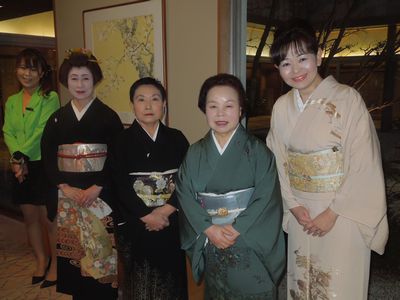
Kamisuwa Geisha, Setsubun 2014
Dances Kappore かっぽれ Takeda bushi 武田節 Kiso bushi 木曽節 Kohan bushi 湖畔節 Ina bushi 伊奈節 Shôchikubai 松竹梅 (performed in the new year season) Tsurukame 鶴亀 (performed at wedding receptions and birthdays) O-Suwa Takashi お諏訪節 Sukêto bushi スケート節 (Ice skating on lake Suwa) Kirigamine kouta 霧ヶ峰小唄 (ice skating) Onhashira kouta 御柱小唄 Suwa ondo 諏訪音頭 (about the beauty of Suwa throughout the seasons) Okaya kouta 岡谷小唄 (about the Okaya silk industry) Numbers 1930's ("early Showa period"): 200 Geisha in Kamisuwa 1958: 80 1960's: 300 2006: 3 History The first Hanamachi on lake Suwa developed in Nawatemachi 縄手町/畷町 in 1903 (renamed to Otemachi 大手町 in 1909). In the following years, a few Ryotei were established. In 1920, the area of Otemachi 1 and 2 chôme was designated as area for Geisha, so Okiya and Ryotei of the neighbouring Izumichô area 和泉町 were moved there. In the early Showa period (1920's/30's), Okiya that were formerly located in Hamamachi also moved to Otemachi. Kamisuwa had two kenban: Ote kenban 大手見番 and Koyanagi kenban 湖柳見番. In Shimosuwa 下諏訪, it seems kenban had no specific names. In Okaya 岡谷, there used to be another Koyanagi kenban 小柳見番 in the Honmachi area. In Chino 茅野, there were Miyagawa kenban 宮川見番 (current Miyagawacho area), and Eimei kenban 永明見番 (current Nakacho area). Before the around 1969/70, Geisha of these respective cities did not work in other cities. But with the decline of Geisha numbers, the Hanamachi in Okaya, Shimosuwa and Chino were no longer able to meet the demands of their customers, so it was allowed for Geisha from Kamisuwa to pad those numbers.
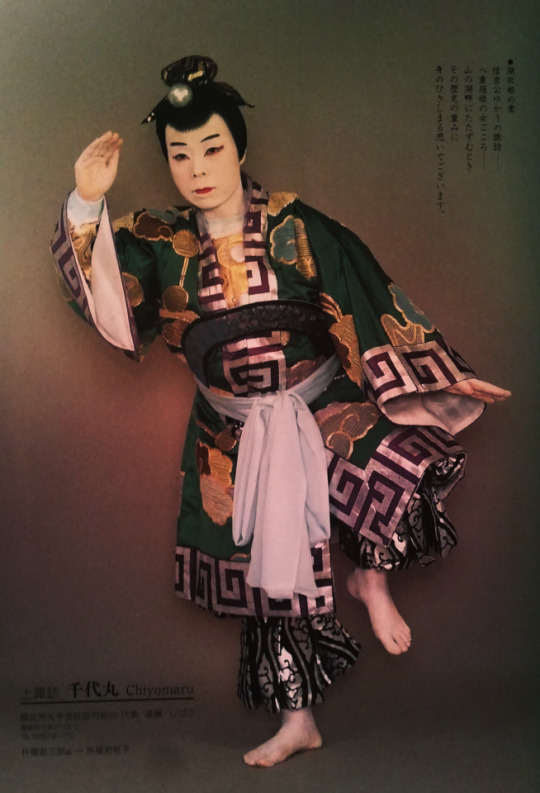
Chiyomaru 千代丸 in "Showa Meigiren", 1988 Daily life Geisha usually practiced their respective arts (such as Narimono, Nagauta, Kouta, dance) until 15:00, afterwards they went to the beauty parlour to get their hair done, put on makeup and change into work clothes. Ozashiki usually lasted for two hours. Style In the year 1935, Geisha still wore their natural hair instead of wigs, and their hairstyle changed, depending on rank and age. Hangyoku wore Momoware 桃割れ and Oshidori おしどり. Geisha under 26 years wore Yuiwata 結い綿 or Taka shimada 高島田, no info on Geisha between 26 and 30, Geisha aged 31 and above wore Geiko yui 芸こ結い, tsubushi (shimada?) つぶし, icho gaeshi 銀杏返, and yokai maki 夜会まき. Around 1955, most Geisha wore short hair or western updos on a daily base and used Nihongami wigs for work. Becoming Geiko Three mediators who acted as go-between of Okiya and families/volunteers worked in Kamisuwa. According to Manchiyo, who worked from 1930 to 44 in Otemachi, the daughters of poor farmers and travelling entertainers were sold to the Okiya for 15 yen. When the parents met with the Okiya, the length of the girl's service was decided. After becoming employed by the Okiya, the girls were doing "odd jobs", while taking lessons in Hanayagi-ryu dance, Shamisen and other arts. It's like Shikomi in Kyoto, although no specific term is named. When a Hangyoku was ready to become a Geisha, she had to prove her skills in dance or shamisen to a council of dance/shamisen teacher, Okiya owner, senior Geisha, head of the Geisha association and a member of the Kenban. The Okiya spent around 30 yen for an Erikae, while the Geisha had to take a loan of 150-200 yen. If her parents were to borrow money during her time before becoming independent, it was added to her loan. If parents continued to ask for money and the Geisha's debt became too large, they often became prostitutes in order to pay off their debts. Around 2 years after becoming Geisha, they became "Goshugi tori" ご祝儀取り - they receive some of the money from the Gyokudai, but tips were entirely for them to keep. The next level was called "share" 分け, when 40% of all earnings were her own. When becoming independent from their Okiya, they paid fees for food and being registered at the place. Most Geisha also had a patron after becoming independent, which also lead to most of them retiring before the age of 30. @gardengeisha yes, this is about Kamisuwa Onsen located in Suwa-gun in Nagano prefecture!
Sources: https://www.saginoyu.com/blog/10090 (2014) 地方花柳界における〈芸〉と〈色〉諏訪湖沿岸 地域の事例 (2015) 花街文化伝える学校が開校/長野・上諏訪温泉 (2008) はなあかり: 昭和名妓連 (1988)
42 notes
·
View notes
Photo





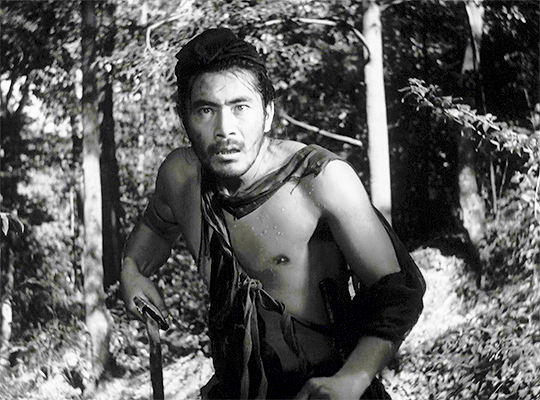
Rashomon (Akira Kurosawa, 1950) Cast: Toshiro Mifune, Machiko Kyo, Masayuki Mori, Takashi Shimura, Minoru Chiaki, Kichijiro Ueda, Noriko Homma, Daisuke Kato. Screenplay: Akira Kurosawa, Shinobu Hashimoto, based on stories by Ryunosuke Akutagawa. Cinematography: Kazuo Miyagawa. Production design: Takashi Matsuyama. Film editing: Akira Kurosawa. Music: Fumio Hayasaka. When I was growing up, Rashomon was one of those films like Federico Fellini's La Dolce Vita (1960) and Ingmar Bergman's The Seventh Seal (1957) that you had to have seen just to be considered culturally literate. Among other things, it's often cited as the career breakthrough of Akira Kurosawa and his frequent star, Toshiro Mifune. But if there's a key to the success of Rashomon as drama it's the performance of MIchiko Kyo in the female lead. Kyo was the star of another 1950s imported hit, Teinosuke Kinugasa's Gate of Hell (1953), and gave memorable performances for Kenji Mizoguchi in Street of Shame (1956) and especially Ugetsu (1953) as well as for Yasujiro Ozu in Floating Weeds (1959). She even crossed the Pacific to play opposite Glenn Ford and Marlon Brando (in yellowface) in the film version of The Teahouse of the August Moon (Daniel Mann, 1956). The nuances of Kyo's performance make Rashomon work; they keep us guessing whether she was the dutiful wife or the savage wanton. As I watch more and more Japanese film of the late 1940s, '50s, and '60s, it becomes clearer that this was a great period for female actors like Kyo, Setsuko Hara, Kyoko Kagawa, Kinuyo Tanaka, Isuzu Yamada, Hideko Takamine, and many others -- most of whose names are unknown to Americans today. As for Rashomon itself, while it remains essential viewing for the cinematically literate, I don't hold it in as high esteem as I do such Kurosawa/Mifune collaborations as Drunken Angel (1948), Stray Dog (1949), Seven Samurai (1954), Throne of Blood (1957), The Lower Depths (1957), The Hidden Fortress (1958), Yojimbo (1961), Sanjuro (1962), or High and Low (1963). Rashomon feels arty and remote in ways that those don't.
gifs by talesfromthecrypts
33 notes
·
View notes
Photo
Yojimbo
T 1961 ‧ Western film/Action ‧ 1h 50m
Yojimbo (Japanese: 用心棒, Hepburn: Yōjinbō, lit. 'Bodyguard') is a 1961 Japanese samurai film co-written, produced, edited, and directed by Akira Kurosawa. The film stars Toshiro Mifune, Tatsuya Nakadai, Yoko Tsukasa, Isuzu Yamada, Daisuke Katō, Takashi Shimura, Kamatari Fujiwara, and Atsushi Watanabe. In the film, a rōnin arrives in a small town where competing crime lords fight for supremacy. The two bosses each try to hire the newcomer as a bodyguard.
A nameless ronin, or samurai with no master (Toshirô Mifune), enters a small village in feudal Japan where two rival businessmen are struggling for control of the local gambling trade. Taking the name Sanjuro Kuwabatake, the ronin convinces both silk merchant Tazaemon (Kamatari Fujiwara) and sake merchant Tokuemon (Takashi Shimura) to hire him as a personal bodyguard, then artfully sets in motion a full-scale gang war between the two ambitious and unscrupulous men.
Release date: April 25, 1961 (Japan)
Director: Akira Kurosawa
Budget: 90.87 million JPY
Sequel: Sanjuro
Cinematography: Kazuo Miyagawa
Adaptations: A Fistful of Dollars (1964), Last Man Standing (1996),
tarring
Toshiro Mifune
Tatsuya Nakadai
Yoko Tsukasa
Isuzu Yamada
Daisuke Katō
Takashi Shimura
Kamatari Fujiwara
Atsushi Watanabe

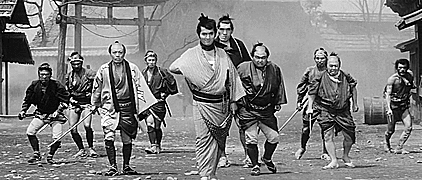

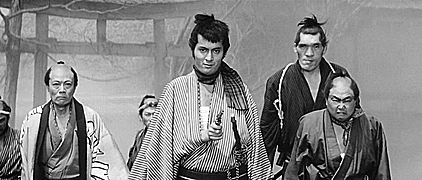
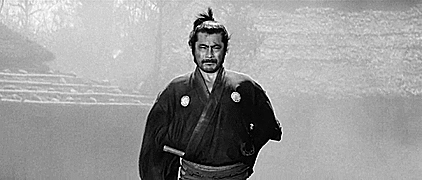
Yojimbo (1961)
1K notes
·
View notes
Photo
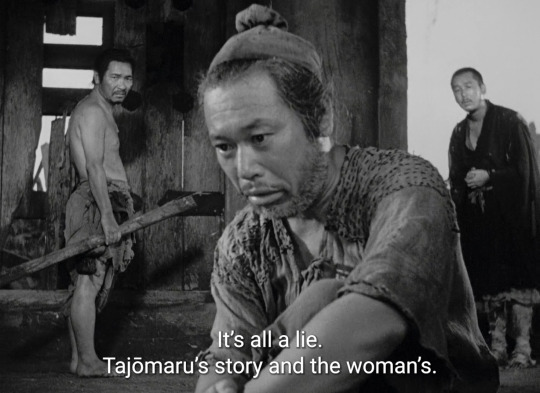

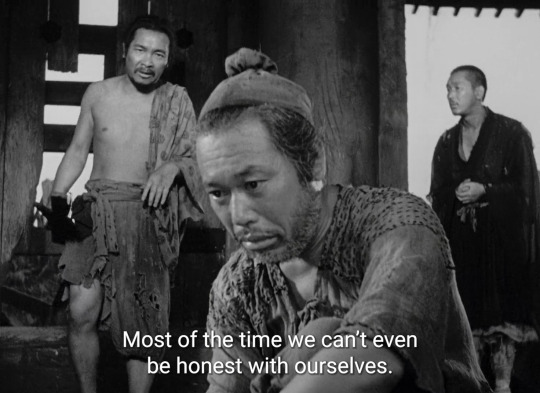
Most of the time we can’t even be honest with ourselves.
#rashomon#akira kurosawa#kazuo miyagawa#takashi shimura#1950#scenephile#film quotes#movie scenes#film scene#movie scene#movie quotes#movie#film
1K notes
·
View notes
Text
Man who dated 35 women at the same time and lied to them about marrying them arrested for fraud
Man who dated 35 women at the same time and lied to them about marrying them arrested for fraud
A Japanese serial dater has been arrested for fraud after dating 35 women at the same time and lying to them about marrying them. Takashi Miyagawa, a part-time worker from the Japanese region of Kansai, had told each of the women he had been dating that his birthday was on a different date in order to receive gifts and cards from them. The 39-year-old was arrested for defrauding the 35 women…

View On WordPress
0 notes
Photo





oshidori utagassen / singing lovebirds (jp, makino 39)
3 notes
·
View notes
Photo

rashomon |1950| akira kurosawa
6 notes
·
View notes
Photo
Give yourself the chance to watch old movies.
You’ll be amazed.










I don’t care if it’s a lie, as long as it’s entertaining. RASHOMON (1950) dir. Akira Kurosawa
#film#filmgifs#rashomon#akira kurosawa#toshiro mifune#such an original movie#Should be mandatory to watch it#1950 cinema#japanese cinema#takashi shimura#machiko kyo#Ryūnosuke Akutagawa#masayuki mori#Kazuo Miyagawa
4K notes
·
View notes
Text
The Gold and Silver Expenditure and Receipt Book (金銀出入帳)
The "Gold and Silver Expenditure and Receipt Book" is a record of the Shinsengumi’s receipts and disbursements, covering the period from the 14th day of the 11th month, Keio 3 (1867) to the 1st day of the 3rd month, Keio 4 (1868). It is approximately ten pages in length and is written in a unique ink script. This record is thought to have been written down by Shinsengumi accountants, and is one of the most valuable official documents of the Shinsengumi for understanding their exact activities and financial situation.
A portion of this document was once published in "Shinsengumi Shimatsuki" (written by Shimozawa Kan in 1928). Until around 1937, it was in the possession of Kondo Isami’s relative, Miyagawa Takashi, who lived in Kamiishihara, Chofu, Tokyo. It’s now kept at Ryugenji Temple (6-chome, Osawa, Mitaka, Tokyo), the site of Kondo Isami’s tomb, along with many other related documents once owned by the Miyagawa family.
The first part of this document is marked with "Start". It then describes the movement of money within the accounting division, and the four people whose names appear in the document, Yasutomi Saisuke, Kishijima Yoshitaro, Otani Isao, and Nakamura Gendo are of course Shinsengumi accountants.
The accountants were usually in charge of bookkeeping, but in times of war, such as the Battle of Toba-Fushimi, they were also assigned to the the logistics division (konida). Yasutomi and Kishijima worked as investigators (諸士調役) (also called "metsuke"), while Otani and Nakamura were treated as the same level as corporals. Some records refer to Otani as an accountant and Nakamura as an equivalent of an accountant.
(source: 新選組史料集)
Out of all the historical texts in 新選組史料集, the Shinsengumi’s account book seemed the most interesting to me, and I kept seeing quotes from it in the articles I’ve read.
It took a while to make sense of the archaic terms and Edo period accounting notation, but I think I’ve mostly figured it out. Here’s my translation: [link], and below are my translation notes and the full original text.
[Read the full translation here]
Translation Notes
一金...也 = formal notation used to clarify and confirm that the money will indeed be paid. Ignore this when translating. (source)
也 = classical modal particle used at the end of sentences to express an explanation or judgement. Ignore this when translating. (source)
右 = classical term of respect. Ignore this when translating. (source)
ニて (にて) = indicates the location where something took place. Ignore this when translating.
江 = river? (not sure why it’s added to some of the entries, but makes more sense to ignore this when translating)
同 = same 一同...也 = 一金...也 同人 = same person as the previous entry
両 = ryo (see: how much was 1 ryo worth?)
分 = bu (1/4 of a ryo)
朱 = shu (1/16 of a ryo)
代 = fee
渡 = transferred
相渡 = handover, transferring from one party to another
手宛 = salary
地役 = easement (the right to use someone else's land for a specific purpose) (source)
入用 = necessary uses
御用 = official duties
帰ル = returned
拾 = ten
廿 = twenty
卯 = year of the rabbit (1867 in this case)
正月 = first month
極月 = twelfth month
一件 = incident
候 or 候事 = the state of things. Ignore when translating.
払 = payment
付 = assistant
Original Text
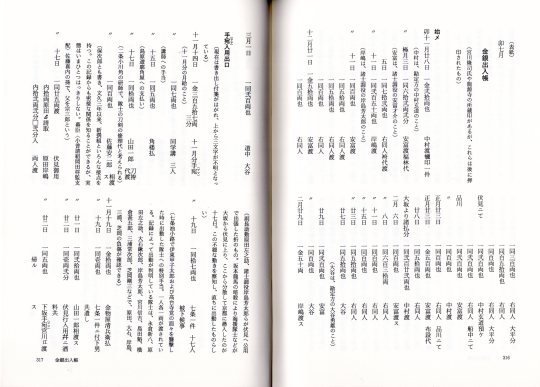


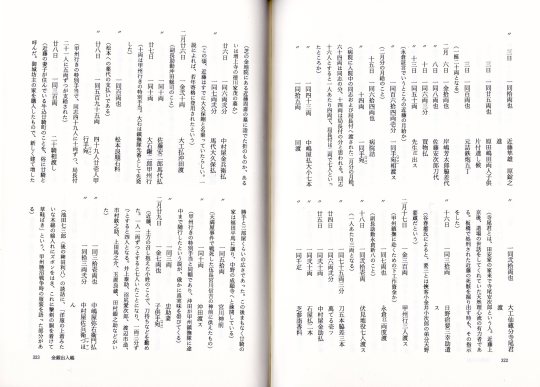
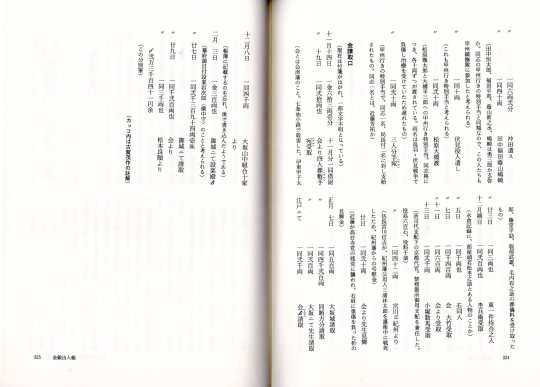
Simplified Text
卯七月
金銀出入帳
(宮川隆司氏や龍源寺の所蔵印があるが、これらは後に押印されたもの)
始メ
卯十一月二十八日 二十両 中村渡蠟印一件 (中村は、勘定方の中村玄道のこと)
十二月三日 六十二両二分 安富渡福林代 (安富は、諸士調役の安富才介のこと)
五日 七十二両 同人袴代渡
十一日 二百五十両 岸嶋渡 (岸嶋は、諸士調役の岸島芳太郎のこと)
十一日 百両 安富渡
五十両 同人渡
五十両 同人渡
百両 同人
十二月二十一日 五十両 安富渡
百両 同人
三百両 同人 大平分
百五十両 同人
百両 同人 大平分
伏見にて 二百両 中村玄道預ケ
二百両 同人 船中にて
品川 二百両 安富渡
百両 中村渡
一月二十三日 百両 同人 品川にて
一月二十三日 五百両 安富渡 布段代
二十八日 五十両 同人
大坂より諸払分 二百二十二両 中村渡
二月六日 百両 安富渡
八日 六百三十両 同人
十一日 百両 同人
十五日 百両 同人
二十三日 五十両 同人
二十七日 五十両 大谷 (大谷は、勘定方の大谷勇雄のこと)
二十九日 二百両 安富
百両 大谷
二月二十九日 五十両 岸嶋渡
三月一日 二百両 道中 大谷
手宛入用出口 (現在は書き出し付箋がはがれ、上から三文字が不明となっている)
十一月十四日 三百五十七両三分 十一月分手宛 (十一月分の月給のこと)
七両 同学講 三人 (講師への手当)
十五日 五両 角楼払 (島原遊廓角屋への支払い)
十七日 十両 山田一郎 刀拵代渡 (二条小川角の研師で、隊士の刀剣の修理代と考えられる)
百両 佐藤安二郎 相渡 (保次郎とも書き、文久三年以来、新撰組といろんな接点を 持つ。この記録からも密接な関係を知ることができるが、実態はいまひとつはっきりしない。幕臣 <小普請組岡田将監支配〉 佐藤喜内の孫で、父を宗三郎という)
十七日 二十五両渡 伏見御用
内十両原田請取 原田岸嶋
内十二両二分□二分入 両人渡 (副長助勤原田左之助、諸士調役岸島芳太郎らが伏見へ公用 で出張した折のもの。坂本龍馬の暗殺により海援隊士などが 大坂から伏見に上り、ここから分散して京都に潜入したのが十七日。この不穏な動きを察知し、直ちに出動したものらし��)
十九日 十七両 七条一件 十七人被 (七条油小路で伊東甲子太郎および高台寺党の面々を襲撃した時に出動した隊士への特別手当。一人各一両が渡されている。記録によって出動が判明している隊士は、永倉新八、原田左之助、大石鍬次郎、岸島芳太郎、宮川信吉、島田魁、横倉甚五郎、三浦常次郎、 芝岡剛三などで、原田、大石、岸島、三浦、芝岡の負傷が確認できる)
十一月十九日 十両 金物屋清兵衛払
十九日 一両 七条一件付下男共遣し
二十一日 二十両 山田一郎相渡
二十二日 一両二分 伏見行入用幷ニ酒料共
二十二日 五両也 帰ル 下坂手宛宮川 渡 (この記載事項は印を押して抹消してある)
二十三日 十両 同入用辛嶋 相渡 (辛島昇司への大坂行きの手当。この辛島は、後に大坂で新撰組を脱走している)
二十三日 五両 荒木新三郎遣し (信三郎とも書く。江戸で病死したと伝わる)
二十六日 十六両二分 大和守身三本 (会津の刀匠大和守源秀国の刀身三本を購入)
十一月二十三日 一二分 御用出入用渡
二十九日 十六両 刀身二本宗安
五両 綿代相渡
十二月 二日 二分二朱 西ノ宮御用行 (上京途上の長州藩兵の様子を探るため、二日夜に西ノ宮へ向かった隊士への費用。翌三日に帰還して作成した報告書が残る)
二日 一二分二朱 土方剣術古手一ツ (「古手」は「籠手」の誤記)
五両 土方入用
六日 十五両 山田一郎相渡
九日 十両 原田渡
二両 宮本 (局長付の宮本騰太のことか)
十二月 十日 六両 着込入用吉村渡
十一日 二百両 歩人足手宛部屋頭 相渡
三百四十四両三分 手宛相渡 (十二月分月給のこと)
三十九両 局長付相渡 (局長付の十二月分月給。局長付池田七三郎の遺談に「十二 月になって一両が渡された」とあるから、三十九人分ということになる)
三千両 山中組十家 返済
十三日 二百二十七両 二条城にて一同 相渡 (特別手当として支給されたもの)
二百両 人足渡部屋頭渡
十両 吉村貫一郎着込 (吉村は本名を嘉村権太郎といい、奥州盛岡藩を脱藩し新撰 組に加入した人で、この時、諸士調役を務めていた)
十五両 賄方忠助福田渡 (忠助とは沢忠輔のこと)
四千九十八両二分 (十一月二十三日の御用出入用渡という記載からの合計金額)
四十五両 山崎烝相渡 (山崎は副長助勤)
二十五両 大坂岩城にて先生 御買物払分 (新撰組は十四日に永井玄蕃頭に従い下坂して、大坂の天満天神に駐屯した。先生とは近藤勇のことである。岩城とは呉服屋のことか)
十両 先生行辛嶋 渡
大坂にて 十六両 局長付残分手宛山崎
十五日 夜 百両 山崎吉村伏見行節 相渡 (新撰組の伏見警備が決まり、偵察と下準備を兼ねて、先発隊として向かったものらしい)
十五日 十両 大坂にて辛嶋渡
十六日 二十五両 伏見地役共被 (十六日、新撰組は大坂を発し、夕方、伏見に到着し、伏見奉行所へ入る)
十両 部屋頭渡伏見人足 入用
十両 大坂表て人夫分 渡
四両 大川七郎相渡代
五十両 先生下坂付山崎 相渡 (十二月十八日、伏見奉行所から二条城へ出向いての帰り、 近藤は高台寺党の残党に鉄砲で右肩を撃たれ、重傷を負った。 会津藩と大坂城の将軍家から医者が来たというが、手当てが 充分できないというので、二十日になって大坂へ赴いた。 沖 田総司も同行し、以後、大坂町奉行屋敷にて療養を続けた。この時に護衛をした山崎烝に預けられたもの)
二十両 伏見部屋頭 相渡
八両 荒木柏村岡田中村残人 相渡
三両 井上源三郎賊相手 節渡 (井上は、副長助勤で三番隊組頭)
四十九両 伏見て歩兵人足 被
十一 十一人賊相手節 (十二月二十一日夜の都城兵との事件に関する特別手当。 一人あたり一両となる)
三十両 伏見部屋頭 相渡
十二月二十八日 百八十五両 伏見にて一同被 (特別手当として支給されたもの)
御口し口
十二���二十八日 三百両 部屋頭 貸渡分
六両 福田平馬相渡
(天然理心流近藤周斎の門人で、神奈川奉行所定役である。 甲州勝沼戦争の時に近藤が神奈川の菜葉隊の応援を期待したのは、この福田の関係からである。明治になって、駿府奉行所支配定番となる)
二十九日 四両 小幡三郎 (+) 行節渡 (薩摩兵の動きを探るため、間諜として潜入する時に渡されたもの)
一両二分 大坂遣ひ人相渡
一月七日 百五十五両 大坂城って一同手 宛渡 (一月分月給のこと)
十八日 五百八十五両 品川宿局中一 同 被三十九 (鳥羽伏見戦争に敗れた新撰組は、大坂天保山沖から富士 丸と順動丸に分乗して江戸へ向かった。 横浜で負傷者を上 陸させ、本隊は品川宿の釜屋半右衛門方を宿所とした。この 時に分配された特別手当で、一人に十五両が渡された)
二百四十両 同局長付二十四人被 下 (一人に十両となる)
百五両 伏見地役七人被 (一人に十五両となる)
百五両 步兵 被 (一人に七両で、十五人か)
六十五両 人足 被 (一人五両で、十三人か)
一月十八日 九十両 役人分被
十五日 百両 横浜病人手宛嶋田 預ヶ置候 (横浜の仏語学校を改造した病院で治療を受けている隊士た ちのことで、伍長の島田魁が世話役として派遣される)
品川にて 二十両 大工仙蔵渡 (近藤の試衛館道場と関係のあった人物)
十八日 二十五両 土方諸買物払
二十二日 三十五両 土方戎屋払 (武器購入の支払い分)
二十三日 二十五両 大工仙蔵相渡
(この日、品川から鍛冶橋御門内の若年寄役屋敷へ移っているので、この役宅の修繕代か)
五両 諸払土方出 (副長土方歳三は、このところ自らいろんな買物をしているようだ)
五両一分二朱 子儘者ぶん硯瀬戸 物色々 (「子儘者」は「小間物」ということだろう)
千八百七十一両三分二朱 (十二月二十八日の部屋頭へ貸渡分という記載からの合計金額)
四百両 大坂先生出分
二十六日 十五両 大工仙藏
二十七日 三百二十両 横浜在留之者相渡
同志十六人局長付六人 人口四人 (一人あたり、同志十五両、局長付十両、人足五両。 これは、 横浜において治療を受けていた隊士たちを岸島芳太郎と尾関泉が迎えに行き、近藤の指示に従って江戸和泉橋の医学所へ移した日に渡されたもの。医学所が収容しきれなかったので、 幡三郎、中山重造、大町通南太郎、大橋半三郎、足立麻太郎、医学館の方へ入ったという。ちなみに鳥羽・伏見戦争で負傷したと考えられる面々は、近藤芳祐、 小原孔三、 粂部正親 山野八十八、 松原幾太郎、 沼尻小文吾、 中條恒八郎、小上原栄作、池田七三郎、和高小刀太、相馬肇、一色善之助、小堀誠一郎などである)
二十八日 五十両 内三十八両帰ル 先生 横浜行持参 (仏人医師の治療を受けるため、横浜へ赴いたもので、この時に近藤と会った通詞田島応親の遺談が残っている)
二十九日 六両 仕立や乙二郎遺
二月二日 三十両 大工仙藏
三日 十両 近藤隼雄 原錠之進
三日 二十五再 原田嶋田両人子供 片付遣し候
三日 百両 元詰鉄炮五丁 (一挺二十両となる)
二月六日 十両 岸嶋芳太郎脇差代
八日 八両 佐藤安次郎刀代
十日 六両三分 買物払
十三日 五十両 先生 出 (永倉証言でいうところの近藤の月給か)
百六十四両一分 手宛相渡 (二月分の月給のこと)
十五日 六十四両 病院詰
十四両 同手宛 (病院に入院中の同志および局長付へ渡された二月分の月給。六十四両は同志の分、十四両は局長付の分と思われる。 同志十六人とすると人あたり四両で、局長付は二両で七人といったところか)
四十三両 中嶋屋払大小七本
十五両 同渡
二十両 大工仙蔵分寺尾君 渡
(寺尾君とは、田安家の家来で寺尾安次郎という人。 近藤上京後、道場の世話をしてくれていた天然理心流の有力者であ る。 板橋で処刑された近藤の死骸を掘り出す時も、その指示をした)
十六日 三十両 日野宿要三幸助遣 (谷春雄氏によると、要三とは侠客小金井小次郎の弟分天野要蔵だという)
二月十七日 三百両 甲州行三人渡 (甲州鎮撫に赴くための下工作資金か)
七両 永倉 両度渡 (副長助勤永倉新八のこと)
十八日 二十一両 伏見地役七人渡 (一人あたり三両となる)
七十五両三分 刀五本脇差三本
二十四日 六両二分
二十五日 二十両 中村屋金払
二十両 石屋弘二本
千疋 芝参詣香料 (芝の金地院にある近藤周斎の墓に詣でた折のものか、あるいは増上寺の徳川家茂の墓か)
二十六日 六両二分 中村屋金兵衛払
七両二分 馬代大久保払 (この頃、近藤はすでに大久保剛と名乗っていたらしい。一説によれば、若年寄格に登用されたという)
二月二十六日 二十両 大工払沖田渡 (副長助勤沖田総司のこと)
十両 佐藤安二郎馬代払
二十七日 十両 大石鍬二郎甲州行 (十両は甲州行きの特別手当。 大石は鎮撫隊先番として先発した)
百両 松本良順石料 (松本への薬代の支払いである)
二十八日 五百九十五両 四十九人二十一人甲 行手定 (甲州行きの特別手当で、同志四十九人に十両ずつ、局長付二十一人に五両ずつが支給された)
二十八日 三百両 二十騎相渡し (近藤の妻子が住んでいる牛込騎町のことを、俗に仕騎と呼んだ。御坊主の家を購入したもので、新しく建て増した勝手と三部屋くらいの広さであった。この後まもなく甘騎の家は福田平馬に譲り、中野の成願寺へと疎開している)
五十両 宮川神前 (天満屋事件で戦死した伍長宮川信吉の神前に供えたもの)
十両 沖田渡 (甲州行きの特別手当と同額であり、沖田が甲州鎮撫隊に途中まで随行したという説が、俄かに真実味を帯びてくる)
三両 忠助妻
二月二十九日 七両 子供手宛 (近藤、土方の召し抱えた小姓のことで、刀持ちなどを勤めた。一人一両ずつとすると七人いたことになり、一両三分ずつとすると四人となる。井上泰助、沼尻愛次郎、渡辺市造、市村鉄之助、上田馬之介、玉置良蔵、 田村銀之助などがいた)
三十一両 中嶋屋弥右衛門払
十三両二分 中村屋佐兵衛づぼん (池田七三郎〈後の稗田利八〉の談話に、「洋服の上着みた いな木綿の綿入れにズボンをはき、これに撃剣の胴を着けて草鞋ばき」という、甲州勝沼戦争時の服装を語った部分がある)
六両二分 沖田遣
四十両 田中福田蔭山嶋崎 (田中恒太郎、福田平馬、 蔭山新之丞、嶋崎は勇三郎か玄弥 か。同志の甲州行きの特別手当と同額なので、この人たちも甲州鎮撫隊に参加したと考えられる)
十両 伏見役人遣し (これも甲州行き特別手当と考えられる)
二十両 松原大橋渡 (松原幾太郎と大橋半三郎への甲州行き特別手当。同志格につき、各十両ずつが渡されている。両名は鳥羽・伏見戦争で負傷し治療を受けていたため遅れたもの)
二十両 三人分手宛 (甲州行きの特別手当で、同志名、局長付二名に対し支給されたもの。同志一名とは、 近藤芳祐か)
金請取口
(現在は付箋がはがれ、一部文字不明となっている)
十一月十四日 六十三両一分 十一月���一同借財
十九日 二十両 会より四人葬敷手 宛受取
(会とは会津藩のこと。 七条油小路で殺害した、伊東甲子太郎、藤堂平助、服部武雄、毛内有之助の葬儀料を受け取った屯の)
二十三日 三両 東一件持合之入
十二月朔日 二百両 杢兵衛受取 (永倉記録に、部屋頭若松杢之助とある人物のことか)
五日 千両 同人
七日 千四百両 会 大竹受取
六百両 会より受取
十三日 二千両 小堀数馬受取 (所司代支配下の京都代官。 禁裡御所御用支配を兼任した。役高六百石、役料千俵)
四十二両 宮川 紀州より (伍長宮川信吉が、紀州藩公用人三浦休太郎を護衛術中に戦死したため、紀州藩からの弔慰金)
二十日 二十両 会より先生見舞 (近藤が高台寺党の残党に襲われ、右肩に重傷を負った折の見舞金)
一月七日 五百両 大坂城請取
四千二百両 同賄方分請取
二百両 大坂先生請取
江戸にて 二千両 会請取
十二月八日 四千両 大坂山中組合十家 より (帳簿に記載するのを忘れ、後で書き込んだようである)
二月三日 三百両 御城設楽殿 (幕府御目付設楽岩次郎〈備中守〉のことと考えられる)
二十七日 二千三百九十四両一朱 御城請取
二十九日 千二百両 会より
三千両 松本良順より 二万三千百四十一円余 (この分別筆)
(カッコ内は古賀茂作の註解)
74 notes
·
View notes
Photo










Rashômon (1950)
Directed by Akira Kurosawa Cinematography by Kazuo Miyagawa
“It’s human to lie. Most of the time we can’t even be honest with ourselves.”
#rashomon#1950#akira kurosawa#kazuo miyagawa#toshiro mifune#machiko kyo#masayuki mori#takashi shimura#cinema#movie#film#still#frame#movie stills#movie frames#cinematography#screencaps#mine#cinemabreak
663 notes
·
View notes
Photo

[Announcement] 舞台『双牙~ソウガ』新炎 (butai souga shinen)
the show will be running from March 5th, 2021 and March 14th, 2021 (Tokyo) @ シアター1010 (Theater 1010)
Cast:
Ino Hiroki as Ouka (オウカ) Izaki Ryuujirou asTsumugi (ツムギ) Sugie Taishi as Shurinosuke (シュリノスケ) Sakurai Keito as Shuzen (シュゼン) Nakamura Tarou as Shinpachi (シンパチ) Tanaka Naoki as Kouei (コウエイ) Kodama Kuniko as Hyakutaka (ヒャクタカ) Koizumi Moeka as Shizukz (シズク) Hagino Takashi as Denbei (デンベイ) Kasahara Shinji as Genshuu (ゲンシュウ)
Miyagawa Yasuhiro Sugawara Takeshi Samukawa Shougo Maeda Ryouga Aita Mahiro Kawashima Shoutarou Fukasawa Yuuto Furukawa Takahiro Endou Takumi
homepage twitter natalie
#双牙#souga#猪野広樹#ino hiroki#伊崎龍次郎#izaki ryuujirou#杉江大志#sugie taishi#櫻井圭登#sakurai keito#中村太郎#nakamura tarou#田中尚輝#tanaka naoki#小玉久仁子#kodama kuniko#小泉萌香#koizumi moeka#萩野崇#hagino takashi#笠原紳司#kasahara shinji#宮川康裕#miyagawa yasuhiro#菅原健志#sugawara takeshi#寒川祥吾#samukawa shougo#前田りょうが#maeda ryouga
16 notes
·
View notes
Text
1 note
·
View note
Text
A Japanese man has been arrested after reportedly dating more than 35 women at the same time in order to get birthday gifts from all of them
He gave each woman a different date for his birthday, ensuring a constant stream of gifts through the year.
1 note
·
View note
Photo



April 23rd, 2019: Congratulations to Kimishō (君翔) of Honjo (本城) in Miyagawa Cho on the occasion of her misedashi! She is the first imōto of Kimiaya (君綾), also of Honjo, who wore the exact same outfit during her misedashi back in 2007! Her unique geimei is a combination of the Kimi (君) that she inherited from her onesan and Shō (翔), which is part of her real name. She is a bit on the petite side, but this only serves to provide her with a great balance in her onesan as Kimiaya is almost 6 feet tall! Kimishō’s misedashi kicks off the second round of misedashi and erikae celebrations that tend to happen in bunches during the year and will be the first of at least six more events before the beginning of June! おめでとうさんどす君翔ちゃん ^o^! Images are courtesy of Tiger Takashi, Ktellusastory, and My Kyoto Photo.
#maiko#geiko#geisha#kyoto#news#misedashi#debut#miyagawa cho#honjo#kimisho#kimishou#kimiaya#舞妓#芸妓#芸者#京都#ニューズ#見世出し#店出し#デビュー#宮川町#本城#君翔#君綾
85 notes
·
View notes
Text
It was FRAUD
But also please I'm begging for clarification on this

How you arrest someone and not know their birthday?
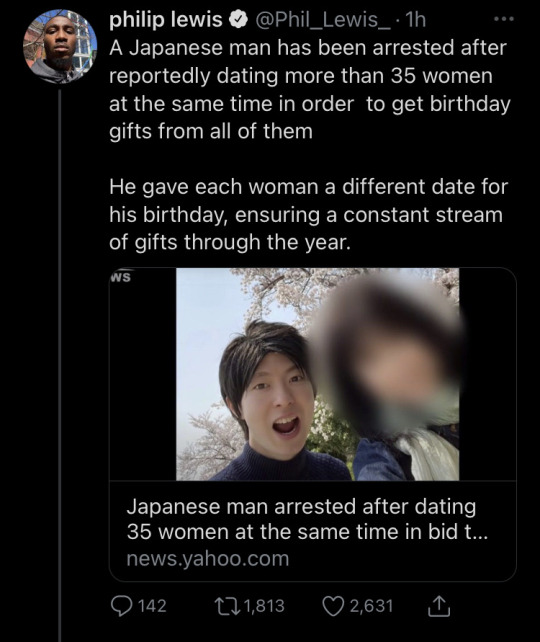
If someone manages to trick 35 different people into thinking they’re dating, I think it should not only not be illegal, but rewarded by a public medal of some kind
118K notes
·
View notes